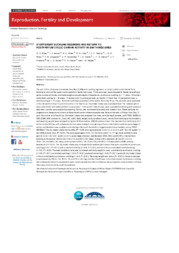Different suckling regimens and return to postpartum cyclic ovarian activity in Santa Inês ewes.
Different suckling regimens and return to postpartum cyclic ovarian activity in Santa Inês ewes.
Author(s): ALVES, N. G.; ASCARI, I. J.; ALVES, A. C.; LIMA, R. R.; GARCIA, I. F. F.; PÉREZ, J. R. O.; JUNQUEIRA, F. B.; FERNANDES, V. P.; VIEIRA, J. A.; MACIEL, L. F. S.; FONSECA, J. F. da; AZIANI, W. L. B.; CASTRO, T. R.; NEPPE, L. M.
Summary: Abstract: The aim of this study was to evaluate the effect of different suckling regimens on body condition and interval from lambing to onset of the cyclic ovarian activity in Santa Inês ewes. Thirty-two ewes were allocated to blocks according to parity, number of lambs, and body weight and submitted to 3 treatments: continuous suckling (n = 11 ewes, 13 lambs), controlled suckling (n = 10 ewes, 14 lambs) with 2 suckling periods per day for 1 h from Day 10 postpartum (pp), or early weaning (n = 11 ewes, 14 lambs) with total separation of the lambs from Day 10 pp. The animals were evaluated in the interval from Day 12 pp to first estrus or to Day 60 pp. Dry matter intake was evaluated daily. The body weight of ewes and lambs and body condition score (scale 1 = thin and 5 = fat) of ewes were evaluated at lambing and at every 6 days after. Lambs were weighed at weaning. Estrus was monitored twice daily with a teaser ram. Blood samples for progesterone measurement were collected and ovarian ultrasonography was done at intervals of 3 days from Day 12 pp to first estrus or to Day 60 pp. Dry matter intake was analyzed over time, considering 9 periods, with PROC MIXED of SAS (2008; SAS Institute Inc., Cary, NC, USA). Body weight, body condition score, interval from lambing to first ovulation, and weaning weight were analyzed using the GLM procedure, ANOVA, and an F-test. The intervals from lambing to first estrus and to follicles with a diameter ≥5 mm were analyzed considering a Poisson distribution and the percentage of estrus manifestation was analyzed considering a Bernoulli distribution, by generalized linear models, using PROC GENMOD. The dry matter intake did not differ (P > 0.05) among treatments (2.3 ± 0.1, 2.2 ± 0.0, and 1.6 ± 0.0 kg day?1), but it differed over time (P < 0.05). The body weight gain (3.3 ± 1.0, 3.0 ± 0.9, and 2.1 ± 1.4 kg), body condition score gain (0.2 ± 0.1, 0.2 ± 0.1, and 0.2 ± 0.1), percentage of estrus manifestation (63.6, 50.0, and 54.5%), interval from lambing to first estrus (45.0 ± 3.9, 44.0 ± 7.2, and 32.3 ± 5.4 days), follicle with a diameter ≥5 mm (31.0 ± 3.3, 33.9 ± 3.0, and 34.9 ± 4.5 days), and ovulation (38.0 ± 3.6, 35.6 ± 3.9, and 26.5 ± 3.2 days) did not differ among treatments (P > 0.05). The dry matter intake was correlated with body weight in ewes that were submitted to continuous suckling (r = 0.7; P < 0.01) and controlled suckling (r = 0.6; P < 0.01), but not in those submitted to early weaning (r = 0.2; P > 0.05). The body condition score was correlated with body weight in ewes submitted to continuous suckling (r = 0.8; P < 0.01), controlled suckling (r = 0.4; P < 0.01), and early weaning (r = 0.5; P < 0.01), and with dry matter intake in those submitted to continuous suckling (r = 0.4; P < 0.01). Weaning weight was lower (P < 0.05) in lambs subjected to early weaning (19.0 ± 1.0, 18.3 ± 1.0, and 15.2 ± 0.6 kg), but their health was not compromised. Continuous suckling did not delay the return to postpartum cyclic ovarian activity and did not influence the postpartum body condition of Santa Inês ewes and should be used by producers.
Publication year: 2013
Types of publication: Abstract in annals or event proceedings
Unit: Embrapa Goats & Sheep
Keywords: Aleitamento, Amamentação, Body condition, Condição corporal, Ewes, Ovino, Postpartum period, Pós-parto, Raça Santa Inês, Sheep, Suckling
Observation
Some of Embrapa's publications are published as ePub files. To read them, use or download one of the following free software options to your computer or mobile device. Android: Google Play Books; IOS: iBooks; Windows and Linux: Calibre.
Access other publications
Access the Agricultural Research Database (BDPA) to consult Embrapa's full library collection and records.
Visit Embrapa Bookstore to purchase books and other publications sold by Embrapa.

